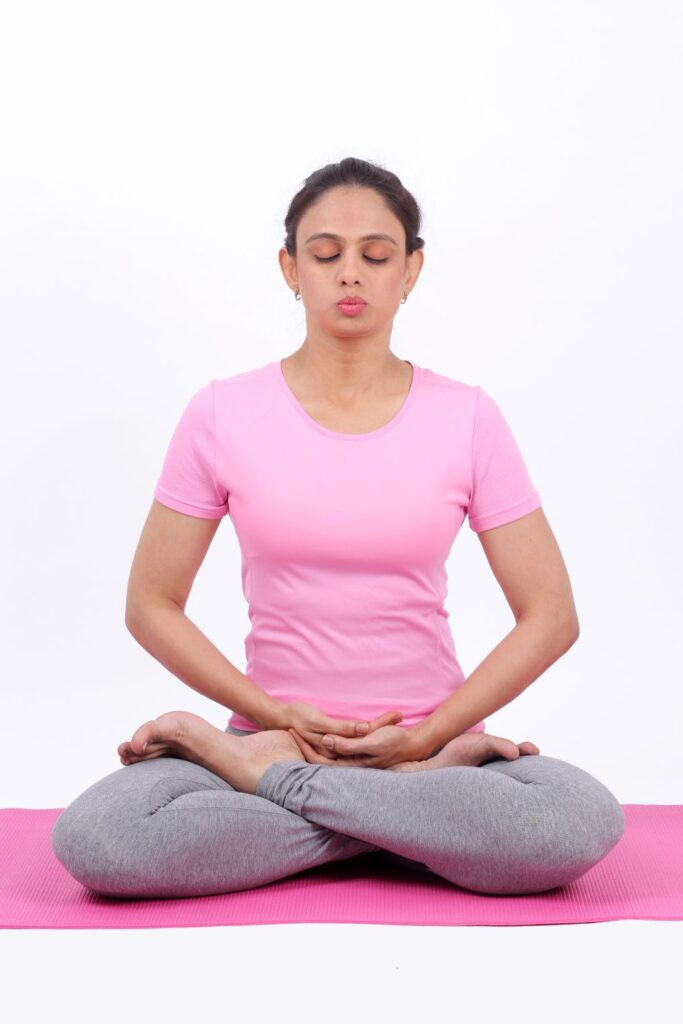
The term burn out is normally considered as a work-related condition as a result of feeling overworked and ineffective, to the point of exhaustion. Symptoms may include fatigue, headaches, depression, anxiety, insomnia, dysregulated body clock, abnormal hormone levels (including thyroid, cortisol and testosterone), low immunity, to name but a few. In short, they may mimic symptoms of elevated stress levels. A way to overcome this challenge is by practice of yoga.
- In the book The Happiness Track, Emma Seppala shares the story of a U.S. marine officer in charge of a convoy across Afghanistan, when his vehicle drove over an explosive device. After the explosion his legs were severely fractured below the knee. In that moment of horror, depression and pain, he remembered a breathing exercise for extreme wartime situations. It allowed him to do his duty, which was to check on everyone else in the vehicle. It also gave him the presence of mind to give orders to call for help, and tourniquet his own legs and prop them up before he fell unconscious – which saved his life!
- A Harvard business review article cited psychosomatic illnesses like type 2 diabetes, coronary heart disease, gastrointestinal issues, high cholesterol and even death for those under the age of 45 related to job burnout.
- In one study, participants went through a three-month meditation training. They then engaged in something called the attentional blink task, in which you watch images appear rapidly one after another. Usually when people do this exercise, their attention doesn’t pick up all of the target images. But after that meditation training, participants were able to pick up more of the target images than earlier. Suggesting that their state of mind had become more attentive. When you’re depressed, you are more likely to react to situations than to respond with reason.
Currently there seems very little medical understanding of the condition “burn out” and the treatment in modern medicine usually may be the use of anti-depressants. Anti-depressants are not good for you, as depression is a possible side effect of the underlying problem of burnout. Not to mention the list of negative side effects from consuming anti-depressant tablets.

Scientists found that breathing, meditation, and asana-based yoga practices increase the alpha wave activity in the brain. This is associated with better perception, calmness and is considered as the most valuable brain waves i.e. “The gold standard”. Our creativity peaks when the brain is in alpha wave mode. (Also referred as neuro yoga or super brain yoga). Thus, it helps overcome feelings of depression and burn out.
Yoga asanas, pranayama, & meditations can help unlock this beneficial state of mind for free! Research findings reported that yogic intervention activates dormant areas of brain while downgrading memories not of interest and upgrading useful ones which is very expedient for people with depression and burn out.

Yoga is described in ancient Indian texts like the Bhagavad Gita and the Yoga sutras of Patanjali which are thousands of years old.
Overview:
- Yogic intervention can increase your overall brain wave (delta, theta, alpha, beta, and gamma) activity. This elevates overall cognitive functions with greater perceived cognition, working memory, attention, focus, positive mind, and perception. Through your breath, you can activate your parasympathetic nervous system and get the brain cells to an Alpha state which induce feelings of calm, increase creativity, and enhance your ability to absorb new information.
- Different frequency brain waves dominate at different times of the day. When you wake up in the morning, for example, your brain passes from the slow delta waves of slumber into the low frequency theta waves that act as a portal between the dream and waking worlds. Then, there are the “alert” beta waves, when you’re engaged in problem solving or decision making. And, the even faster gamma waves, when you’re full of adrenaline and energy, feverishly multitasking.
- Yoga is a medically recommended form of treatment for reducing the feeling of burn out and depressed. It helps to release the body and mind from a state of “fight-or-flight” a Sympathetic Nervous System (SNS) response and bringing it into a state of “rest-and-digest”, when the parasympathetic nervous system (PNS) is engaged. The “rest-and-digest” state is vital to the human body in order for healing and regeneration to occur, where the body performs activities, such as digesting, detoxifying, eliminating and building immunity. Since the effectiveness of yoga tends to increase the longer you continue with it, it offers a path to steady, gradual, improvement.
- The adrenal glands also require “toning” in order for the hormones secreted to initiate a PNS or SNS response to be picked up. Well-functioning adrenals allow the body to move efficiently between a state of PNS & SNS as needed, which is often what is lacking in the case of burnout.
- Depression and burnout makes us narrowly focused, preventing us from seeing the bigger picture. When we’re calmer, our attention becomes broader. We’re more likely to notice if a colleague looks burned out or sad and not get irritated if they don’t perform as we expect. When you’re in a calmer and happier place, that’s probably the day when you’re able to communicate with them in more powerful ways. You’ll notice your colleague and take the time to help them.
Some yoga practices for depression and burn out as below, with links to some videos:
If you feel dizzy while practicing, stop and start normal breathing while seated or lying down.
1.Surya Namaskar or Sun salutation reduces stress by bringing awareness to the mind body and breath. It is a set of 12 postures that can be done starting from the right and then from the left side of the body to make a total set of 24 postures. Beginners can start with 2-3 sets and then progress to 6 sets or more.
2.Tadasana (palm tree pose) Avoid if you suffer from vertigo, low blood pressure or have a severe headache. Helps improve focus and strengthen the nervous system.

Technique
- Stand with your feet planted firmly on the ground, close to each other.
- Straighten the hands by the sides of your body & focus your attention to a point in front.
- Raise your heels and at the same time stretch arms upwards, balancing on your toes.
- Slowly bring the toes back to the floor and the hands down at same time.
2. Ushtrasan (camel pose): backward bend to gain confidence, calms the mind and builds emotional stability. Avoid in case of knee or spinal issues.

Technique:
- Kneel on the floor with knees and feet shoulder-width apart. Place palms on the back of the hips, extend shoulders and elbows back.
- Inhale expand chest and take head up and bend backwards. Hold for as long as comfortable.
- To release exhale and slowly come back to centre.
3. Vakrasan (The Twisted Pose) Opens up chest, shoulder & neck. Tones the spinal nerves and the abdominal organs. Avoid in case of hips, shoulder or neck issues or recent abdominal surgery.

Technique:
- Sit on the floor with legs stretched out and hands resting on the floor by the side.
- Bend left leg with sole of the foot resting on the floor with the right leg straight on the floor.
- Twist the trunk towards the left and bring the right hand over the left leg to either hold the left toe or ankle. Place the left hand behind, to support the weight of the body. The neck is twisted back from the left side, in line with the trunk.
- Maintain this final pose for as long as you are comfortable with normal breathing.
- To release inhale and come to centre. Repeat these steps on the right side.
4. Trikonasana (triangle pose) This is a lateral bending asana which improves lung capacity, good for toning the waist. It stimulates the nervous system and alleviates nervous depression.
Avoid if suffering from back conditions.

Technique
- Stand erect with the feet more than shoulder width apart, turn the right foot to the right side.
- Stretch the arms sideways and raise them to shoulder level in one straight line, inhale.
- Bend to the right with exhalation, taking care not to bring the body forward. Keep knee straight. Place the right hand on the right foot, keeping the two arms in line with each other.
- If comfortable look up at the left hand in the final position or look to the front
- Return to the upright position with the arms in a straight line. Repeat on the other side, this is one round. Practice 2-3 rounds.
- Maintain awareness on the stretch along the side of the trunk, legs and arms,
Tip: Lean against a wall to help ensure you don’t bend forward
4. Anulom Vilom (alternate nostril breathing) It induces focus, tranquility, clarity of thought and concentration. It is recommended for those engaged in mental work. Anulom vilom should be avoided while suffering from colds, flu or fever.

Technique:
- Sit comfortably on a mat or on a chair with back straight.
- Close the right nostril with the right thumb and breathe in from the left nostril. Close both nostrils and hold breath in. Then close left nostril with the ring finger of the right hand and breathe out from the right nostril.
- Now breathe in deeply from the right nostril, close both nostrils, hold breath and then close the right nostril and breathe out deeply from the left nostril. This is one round. Practice 5 to 10 rounds for a start. Breathing process must be slow, controlled and relaxed.
5. Bhramari Pranayama (humming bee breath): It induces a meditative state by harmonizing the mind and directing the awareness inward. Practice to be avoided in case of throat infections.

Technique:
- Sit in any meditative pose with head and back straight, right palm resting on left in Padma mudra.
- Close the eyes and relax the whole body. Close the lips gently throughout the practice.
- Breathe in through the nose and exhale slowly and in a controlled manner while making a deep steady humming sound like a black bee. This is one round, repeat 4-5 rounds.
6. Sheetali Pranayama (cooling breath). A tranquilizing pranayama. It has a calming effect on the entire nervous system and stimulates the parasympathetic nervous system which induces muscular relaxation.
Precaution: avoid the practice in a polluted atmosphere/outdoors or during cold weather.

Technique:
- Sit in any comfortable meditative posture with head and spine up straight.
- Extend the tongue outside the mouth and form a longitudinal tube. Inhale and draw the breath in through this tube. After inhalation, draw the tongue in, close the mouth and exhale through the nose. This is one round.
- If you cannot form a tube of the tongue, form an ‘O’ of the lips instead and do the practice.
Links for meditation practices:
- Visualization meditation (https://learn.amiyogaglobal.com/courses/guided-meditation-and-yoga-nidra/contents/61dfe2dbb7935)
- Inner silence meditation https://learn.amiyogaglobal.com/courses/guided-meditation-and-yoga-nidra/contents/61dfe2dbb7935
- Gratitude meditation https://learn.amiyogaglobal.com/courses/guided-meditation-and-yoga-nidra/contents/615a9a309cf30
As you meditate set up some self-affirmations in your mind e.g.: “I choose to be happy every day and make others happy”; or “I believe in myself and am successful and confident “…. Try creating some of your own.
The world of nonstop connectedness will remain with technology continuing to blur the lines between home and work. While you may not be in charge of what’s going on around you, you are in charge of what happens in your own mind. Yoga is a holistic practice to keep you elevated physically, mentally and spiritually.
Try the asanas, pranayama’s and meditation practices shared above to keep you staying amped up and in control of your life!!
To learn more, get in touch with us at https://amiyogaglobal.com/old
References:
- Asana, Pranayama, Mudra, Bandha by Swami Satyananda Saraswati
- Yoga practices for stress management – Mrs.Usha Karnik
- health.com/condition/stress/burnout
- greatergood.berkeley.edu/article/item/four_ways_to_calm_your_mind_in_stressful_times
- health.harvard.edu/staying-healthy/understanding-the-stress-response
- journals.lww.com/greenjournal/Abstract/2019/05000
- psychiatryonline.org/doi/full/10.1176/appi.ajp.2020.19090902
- atlassian.com/blog/productivity/alpha-brain-waves-are-associated-with-a-flow-state-of-mind-



